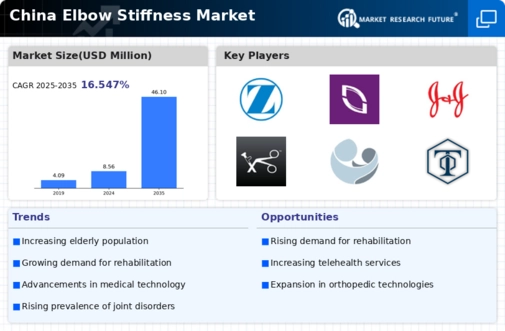Rising Healthcare Expenditure
China's increasing healthcare expenditure is a pivotal factor influencing the elbow stiffness market. With the government prioritizing healthcare reforms and expanding insurance coverage, more individuals are seeking medical attention for joint-related issues. In 2025, healthcare spending is projected to reach approximately 7.5% of GDP, indicating a robust investment in health services. This trend is likely to enhance access to treatments for elbow stiffness, thereby driving demand within the market. The elbow stiffness market may benefit from this increased spending as healthcare providers invest in advanced treatment options and rehabilitation services. Furthermore, the growing emphasis on preventive care could lead to a rise in consumer awareness and demand for products aimed at maintaining joint health.
Aging Population and Joint Health
The aging population in China is a critical driver for the elbow stiffness market. As individuals age, the prevalence of joint-related issues, including stiffness, tends to increase. According to recent statistics, approximately 18% of the population is over 60 years old, a demographic that is particularly susceptible to conditions such as osteoarthritis. This demographic shift is likely to escalate the demand for elbow stiffness treatments and therapies. Furthermore, the elbow stiffness market may experience growth as healthcare providers focus on developing targeted interventions for older adults. The increasing number of elderly individuals seeking relief from joint pain and stiffness could lead to a surge in market opportunities, prompting manufacturers to innovate and expand their product offerings to cater to this demographic's specific needs.
Growing Focus on Preventive Healthcare
The growing focus on preventive healthcare in China is significantly impacting the elbow stiffness market. As awareness of the importance of maintaining joint health increases, more individuals are seeking preventive measures to avoid stiffness and related issues. This trend is reflected in the rising demand for supplements, exercise programs, and educational resources aimed at promoting joint health. The elbow stiffness market may experience growth as consumers prioritize proactive approaches to health management. Additionally, healthcare providers are likely to incorporate preventive strategies into their practices, further driving demand for products and services that support joint health. This shift towards prevention could lead to a more informed consumer base, ultimately benefiting the elbow stiffness market.
Technological Innovations in Treatment Solutions
Technological advancements in treatment solutions are reshaping the elbow stiffness market in China. Innovations such as minimally invasive surgical techniques, advanced physiotherapy equipment, and digital health solutions are becoming increasingly prevalent. These technologies not only improve treatment outcomes but also enhance patient experiences. For instance, the introduction of telehealth services allows patients to access consultations and follow-up care conveniently, which may lead to better management of elbow stiffness. The elbow stiffness market is likely to see a surge in demand for these innovative solutions as healthcare providers adopt new technologies to improve patient care. As a result, manufacturers may need to invest in research and development to stay competitive in this evolving landscape.
Increased Participation in Sports and Physical Activities
The rising interest in sports and physical activities among the Chinese population is another significant driver for the elbow stiffness market. As more individuals engage in recreational and competitive sports, the incidence of sports-related injuries, including elbow stiffness, is likely to rise. Reports indicate that around 30% of the population participates in regular physical activities, which can lead to overuse injuries. This trend suggests a growing need for effective treatments and preventive measures within the elbow stiffness market. Consequently, manufacturers may focus on developing specialized products, such as braces and topical treatments, to address the unique challenges faced by athletes and active individuals. The increasing awareness of the importance of joint health in sports could further stimulate market growth.

















Leave a Comment